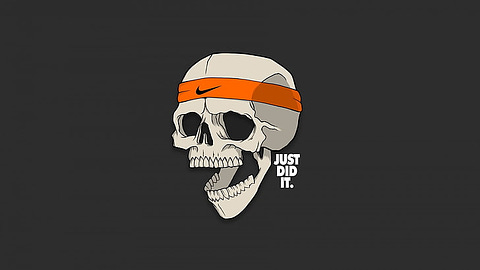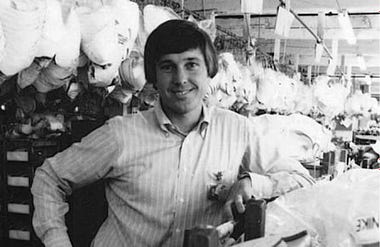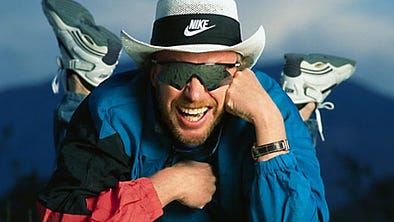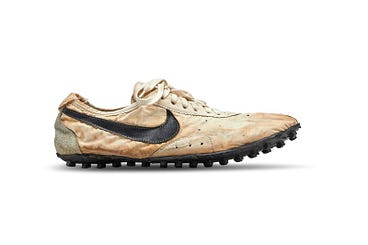First 1000 - 👟 Nike
👟 NikeThe story of a 7 year pivot, a hostile takeover, and behind the scenes on the creation of one of the most beloved brands in the world. The Nike case study is the best one yet!
Hello folks 👋, First of all, I would like to welcome the 661 new members to our little family 👨🏽🍼. First 1000 is now 20,761 members strong. Now to the fun stuff 😃 This week, we are diving deep into the story of Nike. For the past week, I have been devouring Phil Knight's memoir on creating Nike "Shoe Dog." Nike is unlike any other case study we have covered here on First 1000; it is not a tech company, was founded more than 50 years ago and for the first 7 years of the life of the company wasn't even making shoes. The History 👵🏻Before Nike became Nike Inc in 1978, it was known as Blue Ribbon. During that earl(ish) period, Blue Ribbon did not produce any of its own shoes. Instead they were importing Onitsuka Tiger shoes from Japan and selling them direct to runners at first (and later in stores). The low cost of labor, rapid industrialization, government incentives, tax break, and the normalization of diplomatic relations between Japan & the USA in the 1950s combined gave the Japanese a unique edge in the global manufacturing arena. This edge could be observed in Fujifilm's (a Japanese camera company) aggressive expansion overseas in the 1950s. It was not long after that Fujifilm started to make waves in the USA camera market. Phil's argued in his paper that this phenomenon was not unique to the photography industry. Soon enough, the world would see the Japanese dominate all sorts of different manufactured goods. While Phil could've made that argument for virtually any industry, he chose track (running) shoes; track shoes had a soft spot in Phil's heart since he used to track at Oregon (his undergraduate alma mater) until 24. After completing his MBA, Phil would embark on an I-dont-know-what-to-with-my-life world trip, during which he would make a stop in Japan and convince Onitsuka Tiger (known as Onitsuka at the time) to send him 12 pair of track shoes that he would try to sell in the USA. The road to 1000 👟Selling the first 12 pairs: Phil leaned heavily on his Oregon University track coach (Bill Bowerman) for selling the first dozen pairs. Bill was no ordinary coach; he was obsessed with giving his players a (legal) edge in whatever shape or form he could. Some of the ways he attempted to do just that included tinkering around with his athletes' shoes (and making modifications to them) + inventing a drink to help them recover after long training days (i.e., Gatorade before Gatorade was a thing). Bill would go on to coach over 30 US Olympic athletes. Phil thought if anyone in the world could discern if these Tiger shoes were any good, it would have to be Bill. Hence, The first thing Phil did after receiving the 12 pairs was to gift coach Bill 2 of them. Bill loved these shoes so much that he bought almost this first shipment entirely for his team. The cherry on top was Bill deciding to jump in as a 49/51 partner with Phil...becoming the second (and last) co-founder of Nike. Selling the next 300 pairs: After the initial success with the test batch, Phil wrote to Onitsuka asking to be their exclusive distributor in the western United States. He immediately ordered 300 pairs To sell the first "real" shipment of the Onitsuka Tiger shoes, Phil went directly to customers when they were most susceptible to experimenting with a new pair of shoes: track meets. The opportunity in selling at track meets was that the timeline from purchase to "aha moment" was orders of magnitude faster than through any traditional distribution channel. In under 5 minutes, a runner can purchase a pair of Tigers, run in them on the track, come back, and share their (unique) experience with fellow runners who in turn can buy them right then.
Track sales and the ripple effect of word of mouth contributed to the majority of the sales of the first 300 pairs. Nevertheless, Phil dabbled a little bit with advertising:
Selling the following 1000 pairs: As Phil started exhausting track meets around Portland, the next step function was expanding geographically and recruiting a couple of salespeople. Phil chose California as his first ground for expansion. The only problem, he was not able to afford airfare every week since all his money was tied up in inventory. To overcome this obstacle, Phil would dress in his army uniform (he was serving in reserves at the time), and left people to "assume" he was an active duty member. Airlines would place him on the subsequent available military transportation to SF or LA- free of charge, of course. Still, traveling to California over the weekends was not enough to sell all these track shoes (Phil was a full-time accountant at the time & could only travel during the weekends). He needed to hire salespeople. The first full-time employee and salesman would be Jeff Johnson. Jeff was a fellow Stanford MBA and track runner. Before joining Nike (or Blue Ribbon), he had a little side hustle going selling Adidas shoes. It took a few months of convincing to get Jeff on board. But as soon as that happened Jeff quickly became obsessed with the Tiger running shoes and Blue Ribbon. The bad kind of obsessed 😬. To an extent where Phil would soon start to question hiring him in the first place.
You see, for Jeff, running was life. It went to the point that he wanted to exclusively socialize with people who shared and "understood" that lifestyle (going for a run was something to be mocked in the 1960s). Selling Tiger shoes was the only avenue available to him to connect with fellow runner enthusiasts who could relate to him and running. Although by accident rather than design, Jeff's desire to personally connect and socialize with other runners would end up being the single most significant lever that helped Nike (Blue Ribbon at the time) sell their first 1000 pairs. Fun Fact 😁: |
If you liked this post from First 1000, why not share it?
Older messages
📊 Mixpanel
Monday, July 26, 2021
For all the people building B2B companies out there
👯TikTok
Sunday, July 18, 2021
Hello folks 👋, First of all, I would like to welcome the 2023 new members to our little family 👨🏽🍼 since last week. First 1000 is this close(👌) to 20000 members. Today's case study is on Tiktok.
Sunday, July 11, 2021
establishing trust through fake users, launching before you are ready and everything you didn't know about how Reddit got their very first customers.
🍫 Mid-Day Squares: Not Your Average Chocolate
Tuesday, July 6, 2021
and how they "Kardashian-ed"their way to getting the first 1000 customers
🍣Snackpass: The Pickup Artist
Sunday, June 27, 2021
Food + Social = $$$
You Might Also Like
🚀 Ready to scale? Apply now for the TinySeed SaaS Accelerator
Friday, February 14, 2025
What could $120K+ in funding do for your business?
📂 How to find a technical cofounder
Friday, February 14, 2025
If you're a marketer looking to become a founder, this newsletter is for you. Starting a startup alone is hard. Very hard. Even as someone who learned to code, I still believe that the
AI Impact Curves
Friday, February 14, 2025
Tomasz Tunguz Venture Capitalist If you were forwarded this newsletter, and you'd like to receive it in the future, subscribe here. AI Impact Curves What is the impact of AI across different
15 Silicon Valley Startups Raised $302 Million - Week of February 10, 2025
Friday, February 14, 2025
💕 AI's Power Couple 💰 How Stablecoins Could Drive the Dollar 🚚 USPS Halts China Inbound Packages for 12 Hours 💲 No One Knows How to Price AI Tools 💰 Blackrock & G42 on Financing AI
The Rewrite and Hybrid Favoritism 🤫
Friday, February 14, 2025
Dogs, Yay. Humans, Nay͏ ͏ ͏ ͏ ͏ ͏ ͏ ͏ ͏ ͏ ͏ ͏ ͏ ͏ ͏ ͏ ͏ ͏ ͏ ͏ ͏ ͏ ͏ ͏ ͏ ͏ ͏ ͏ ͏ ͏ ͏ ͏ ͏ ͏ ͏ ͏ ͏ ͏ ͏ ͏ ͏ ͏ ͏ ͏ ͏ ͏ ͏ ͏ ͏ ͏ ͏ ͏ ͏ ͏ ͏ ͏ ͏ ͏ ͏ ͏
🦄 AI product creation marketplace
Friday, February 14, 2025
Arcade is an AI-powered platform and marketplace that lets you design and create custom products, like jewelry.
Crazy week
Friday, February 14, 2025
Crazy week. ͏ ͏ ͏ ͏ ͏ ͏ ͏ ͏ ͏ ͏ ͏ ͏ ͏ ͏ ͏ ͏ ͏ ͏ ͏ ͏ ͏ ͏ ͏ ͏ ͏ ͏ ͏ ͏ ͏ ͏ ͏ ͏ ͏ ͏ ͏ ͏ ͏ ͏ ͏ ͏ ͏ ͏ ͏ ͏ ͏ ͏ ͏ ͏ ͏ ͏ ͏ ͏ ͏ ͏ ͏ ͏ ͏ ͏ ͏ ͏ ͏ ͏ ͏ ͏ ͏ ͏ ͏ ͏ ͏ ͏ ͏ ͏ ͏ ͏ ͏ ͏ ͏ ͏ ͏ ͏ ͏ ͏ ͏ ͏ ͏ ͏ ͏ ͏ ͏ ͏ ͏ ͏ ͏ ͏ ͏
join me: 6 trends shaping the AI landscape in 2025
Friday, February 14, 2025
this is tomorrow Hi there, Isabelle here, Senior Editor & Analyst at CB Insights. Tomorrow, I'll be breaking down the biggest shifts in AI – from the M&A surge to the deals fueling the
Six Startups to Watch
Friday, February 14, 2025
AI wrappers, DNA sequencing, fintech super-apps, and more. ͏ ͏ ͏ ͏ ͏ ͏ ͏ ͏ ͏ ͏ ͏ ͏ ͏ ͏ ͏ ͏ ͏ ͏ ͏ ͏ ͏ ͏ ͏ ͏ ͏ ͏ ͏ ͏ ͏ ͏ ͏ ͏ ͏ ͏ ͏ ͏ ͏ ͏ ͏ ͏ ͏ ͏ ͏ ͏ ͏ ͏ ͏ ͏ ͏ ͏ ͏ ͏ ͏ ͏ ͏ ͏ ͏ ͏ ͏ ͏ ͏ ͏ ͏ ͏ ͏ ͏ ͏ ͏ ͏ ͏ ͏
How Will AI-Native Games Work? Well, Now We Know.
Friday, February 14, 2025
A Deep Dive Into Simcluster ͏ ͏ ͏ ͏ ͏ ͏ ͏ ͏ ͏ ͏ ͏ ͏ ͏ ͏ ͏ ͏ ͏ ͏ ͏ ͏ ͏ ͏ ͏ ͏ ͏ ͏ ͏ ͏ ͏ ͏ ͏ ͏ ͏ ͏ ͏ ͏ ͏ ͏ ͏ ͏ ͏ ͏ ͏ ͏ ͏ ͏ ͏ ͏ ͏ ͏ ͏ ͏ ͏ ͏ ͏ ͏ ͏ ͏ ͏ ͏ ͏ ͏ ͏ ͏ ͏ ͏ ͏ ͏ ͏ ͏ ͏ ͏ ͏ ͏ ͏ ͏ ͏ ͏ ͏ ͏ ͏ ͏ ͏ ͏ ͏ ͏ ͏




